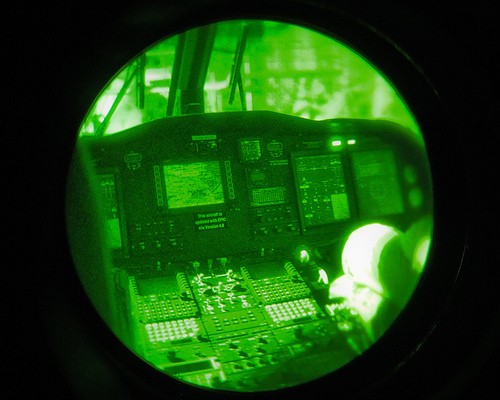By Dane Lorica, | December 14, 2016

Nanotechnology can improve night vision devices that are usually used in battlefields. (Irish Air Corps/CC BY 2.0)
Scientists have found a new way to improve night vision devices through nanotechnology. The Australian National University have developed a pair of night vision goggle (NVG) that is thinner than a typical eyeglass.
Like Us on Facebook
Devices such NGVs are often used on battlefields and require constant improvement to ensure the safety of users. While conventional NVGs affects the peripheral view of the user, modern L-3 Ground Panoramic NGVs (like the one that the US special forces wore during the hunt for Osama Bin Laden) are inconveniently heavy and requires an external power source.
Conventional night vision gears are dependent on cascaded secondary emission from near-infrared lights gathered by the objective lens. Electrons converted from photons will be vacuumed onto a hole-filled plate which will create a chain reaction necessary for the production of green-tinted images. Electron generation requires a high volume of electricity which makes an external power source essential during operations.
The latest discovery uses aluminum gallium arsenide nanostructure in the absence of vacuum tubes.
"We managed to fabricate very teeny, tiny structures. Those magic structures are capable of changing the intensity of the light, change the shape of the light, and at the same time, change the color of the light," researcher Mohsen Rahmani said.
The researchers further explained that human eyes have the capacity to see light only in the visible spectrum. However, with the latest nanotechnology discovery, fabricating an "area of nanostructures on flat surfaces like glass" may enable the conversion of invisible light in the dark.
The study clarified that the gadget would need an external energy source but this time it would be smaller than what conventional NVG's require. Its thinner feature is due to the very small nanocrystals that can actually fit into "ultra thin film to normal eye glasses to enable night vision," Professor Neshev of the Nonlinear Physics Center said.
-
Use of Coronavirus Pandemic Drones Raises Privacy Concerns: Drones Spread Fear, Local Officials Say

-
Coronavirus Hampers The Delivery Of Lockheed Martin F-35 Stealth Fighters For 2020

-
Instagram Speeds Up Plans to Add Account Memorialization Feature Due to COVID-19 Deaths

-
NASA: Perseverance Plans to Bring 'Mars Rock' to Earth in 2031

-
600 Dead And 3,000 In The Hospital as Iranians Believed Drinking High-Concentrations of Alcohol Can Cure The Coronavirus

-
600 Dead And 3,000 In The Hospital as Iranians Believed Drinking High-Concentrations of Alcohol Can Cure The Coronavirus

-
COVID-19: Doctors, Nurses Use Virtual Reality to Learn New Skills in Treating Coronavirus Patients







